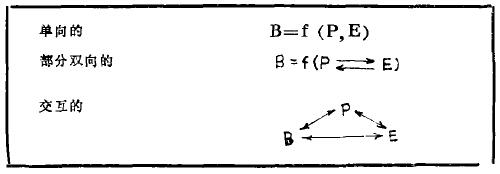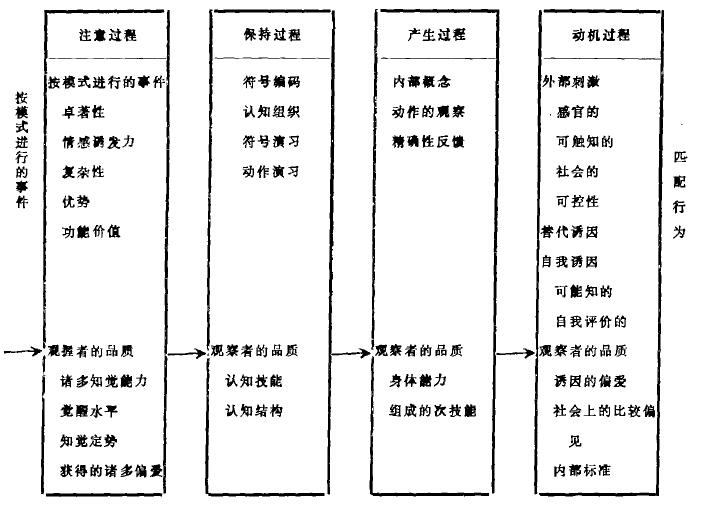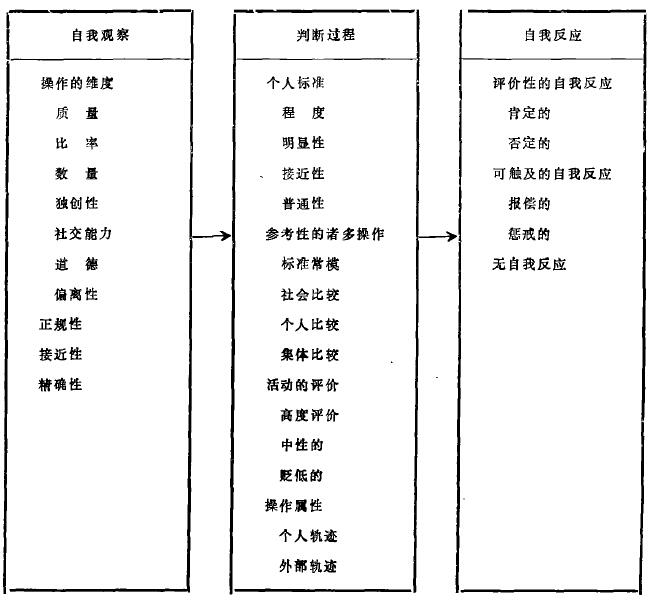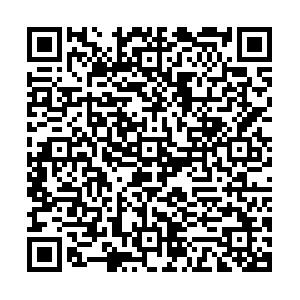|
[1]
|
Bandura, A.Prinaciples of behavior modification. New York; Holt, Rioehart & Winsto, 1969.
|
|
[2]
|
Bandura, A. Social lcarning theory.Englcwood Cliffs, N.J.; Prentice-Hall, 1977.(a)
|
|
[3]
|
Bandura, A. Self-efficacy: Toward a upifying theory of bebavioral change. Psychological Review, 1977, 84, 191 - 215.(6)
|
|
[4]
|
Bandura, A.The self system in Teciprocal determioism. American Psychologist, 1978, 33, 344 - 358.
|
|
[5]
|
Bandura, A.Self-efficacy mecbanism in bumao agency. American Psycbologist, 1982, 37, 122-147.(a)
|
|
[6]
|
Bandura, A.The self and mechanisms of agency. In J.Suls (Ed.), PsychologiCal perspeCtives on the sc1f(Vol, 1), Hillsdale, N.J.; Erlbaum, 1982.(b)
|
|
[7]
|
Bandura, A.The psychology of chance encounters and life paths. American Psychologist, 1982, 37, 747-755.(c)
|
|
[8]
|
Bandura, A. & Cervone, D. Self-evaluative and self-effiCa cy mechanisms jo the mo andtivational effect of goal systems. Journal of Personality and Social Psycbo1ogy, 1983, 45, 1017-1028.
|
|
[9]
|
Bandura, A. & Jeffery, R.W. role of symbolic coding and rehearsal processes i observational learniog.Jouroal of Petsonality and Social Prycbology, 1973, 26, 122- 130.
|
|
[10]
|
Bandura, A. & Scbunk, D. H, Cultivatiog competence, se1f-efficacy, and intiosic intercst through pro-ximal se1f-motivation. Journal of PeTsonality and Social Psychology, 1931, 41, 586-598.
|
|
[11]
|
Baron, A., Kaufman, A., & Stauber, K, A, Effects of instructions and reinforcement feedback on bu-man operant behavior maintained by fixed interval reinforcement. Journal of the Experimental Analysis of Behavor, 1969, 12, 701-712.
|
|
[12]
|
Beck, A. T. Cogoitive therapy and the emotional disorders. New York; International Universities Press, 1976.
|
|
[13]
|
Bower, G, H. cogpitive psychology. An introduction. In W. K. Estes(Ed.), Handbook of lcaroing andcognitiop. Hillsdale, N.J. Erlbaum, 1975.
|
|
[14]
|
Bowers, K, S. Situationism in psychology: An analysis and a critiquc. Psycbological Review, 1973, 80, 307-336.
|
|
[15]
|
Brewer, W. F. There is no convinciog evidence or opsrant or Classica1 conditioning in adult bumans.In W.B,1974
|
|
[16]
|
B.Weimer & D.S.Palermo(Eds.), Cognition and the 8ymbolic processos. Hillsdalc, N.J, ; Erlbaum, 1974.
|
|
[17]
|
Bunge, M. The mind-body problem; A psychobiological approach, Oxford, Porgamon Press, 1980.
|
|
[18]
|
Cairos, R, B, (Ed, ). The analysis of social interactions, Methods, issues, and ilustratios, Hillsdale, N.J. ErIbaun, 1979.
|
|
[19]
|
Carroll, W.R., & Bandura, A. The rolo of visual monitoring in observational.learning of action patterDsi Making the unobsetvable observable, Journa1 of Motor Behavior, 1982, 14, 153-167.
|
|
[20]
|
Dulany, D.E. Awareness, tults, and propositioal control: A confrontation with S-R behavior tbory.InT. R, Dixon & D. L. Hotton(Eds.), Verbal behavior and general behavior theory. Eoglewood Cliffs, N.J. Prentice-Hall, 1968.
|
|
[21]
|
Endler, N.S., & Magusson, D. (Eds, ). Ioteractional psychology and persopality. Washington, D.C.: Hemisphero, 1976.
|
|
[22]
|
Flavell, J.H. Metacognitive development. In J, M. Scandura & C. J, Brainerd(Eds.), Structural pto-cess theories of complex human behavior. Alphena. d. Rijn, The Netherlandsn Sijthoff and Nord-dhoff, 1978.
|
|
[23]
|
Hicks, D, J.GirIs attitudes toward modeled bebaviors and the content of imitative private play. Cbild Development, 1971, 42, 139-147.
|
|
[24]
|
Lazarus, R.S., & Launier, R. Stress-telated transactions between person and eovironmont. In L. A. Petvin & M. Lowis(Eds), Perspectives in interactional psychology, New York; Plenum Press, 1978.
|
|
[25]
|
Locke, E.A, Shaw, K.N, Saari, L. M., & Latham, G.P. Goal settiog and task performance: 1969-1 980. Psycbological Bltetin, 1981, 90, 125-152.
|
|
[26]
|
Meicbeobaum, D. H. Cognitive-bebavior modification Ao integrative approacb. New York, Pleoum Press, 1977.
|
|
[27]
|
Midgely, M. Beast and man, The toots of buman naturo. Ithaca, N. Y.: Cornoll Uoiversity Press, 1978.
|
|
[28]
|
Neisser, U. Cogition and reality; Principles and implications of cogitive psychology. San FrancisCOn FreemaD, 1978.
|
|
[29]
|
Patterson, G, R. The aggressive child, Victim and architect of a coercive system. InE. J. Masb, L. A.Hamet1ynck, & L.C, Handy(Eds.), Behavior modification and families. New York, Bruooer/ Ma-zck, 1976.
|
|
[30]
|
Rosenthal, T.L, Cognitive socia1 learming theory. Io N.S. Eodler & J.McVicker Hunt(Eds), Poronality and tho bebavior disorders(rev.cd.). Now York; Wiloy, 1984.
|
|
[31]
|
Rosenthal, T.L, & Zimmnerman, B. J. Social learoiog and cogition. New York, Academic Pres, 1978.
|
|
[32]
|
Sarason, I.G. Axioty and selt-ptcoccupation. Io I.G. Sarason & C. D. Spiclberget(Eds.), Stress and anxiety(Vo1.2).Washiogton, D.C.Hemispbere, 1975.
|
|
[33]
|
Scbneider, D.J, Hastorf, A.H., & Bllsworth, P. C. Person perception(2nd ed, ). Readiog, Mass.1 Addison-Wesley, 1979.
|
|
[34]
|
Skioner, B, F. About bebaviorism. New York: Koopf, 1976.
|
|
[35]
|
Snyder, M. Seek, and ye shall find, Testing bypotbeses about othor peoplo. In E.T. Higgins, C. P.Herma0, & M. P. Zaona(Eds.), Social cogpition; The Ontario synposium on personality and social psychology(Vol.1), Hilsdale, N. J. ErIlbaum, 1980.
|
|
[36]
|
Snyder, M. On the solf-perpotuating DatuTc of socia1 stertotypes. ln D.L. Hamilton(Ed.). Cognitive processes in stcreotyping and intergtoup bebavior. Hillscdale, M.J.; Erlbaum, 1981.
|
|
[37]
|
Sukemune, S, Haruki, Y & Kashiwagi, K. Studies on social learpiog in Japan. American Psychologist, 1977, 32, 924-933.
|
|
[38]
|
Thelen, M.H., & Rennie, D. L, The effect of vicatious reinforcement on imitation; A review of the literature. Io B.H.Maber (Ed), progress in experimenral personality research(Vol.6)New York, Academic Press, 1972.
|
|
[39]
|
Thomas, E.A.C., & Malooe, T. W. On the dyoamics of two-pcrson interactions. Psychological Review 1979, 86, 331-360.
|
|
[40]
|
voo Cranach, M., Foppa, K, Lepenics, W., & Ploog, D. (Bds.).Human etbology; Claims and limits of a new discipline. Cambridge, Bogland, Cambridge University Press, 1979.
|
|
[41]
|
Zimbardo, P.G., Ebbesee, E.B., Maslach, C. lofluenciog attitudes and chaoging behavior. Reading, Mass.. Addison-Wesley, 1977.
|






 下载:
下载:



